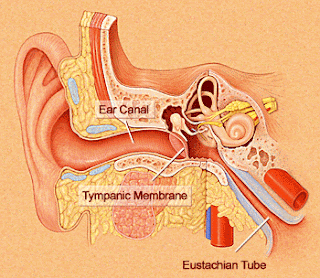Continuing the discussion from my previous post, a systematic review of diagnosis and management of Acute Otitis Media (AOM) has been published in the Journal of the American Medical Association. In light of the above, it would be appropriate to undertake a short review of the pathology and the clinical features of acute otitis media.
Pathophysiology
Changes in the middle ear cleft can be described in stages.
 |
| Mechanism of development of acute otitis media |
Complications may occur with inadequate treatment or ill drainage which results in persistence of the infection and the disease may spread beyond the mucoperiosteum of the middle ear to involve the mastoid or may move intracranially.
Clinical features
The signs and symptoms of acute otitis media vary with the stage of the disease.
- Stage of tubal occlusion – Features of acute coryza is observed with running nose and sneezing. The patient complains of fullness of the affected ear with mild pain and hearing loss. This stage usually passes unnoticed in children
- Stage of pre-suppuration – The most prominent symptom in this stage is earache. The pain is severe and awakens the child at night. The pain is sharp and stabbing in nature. Hearing loss also increases in this stage and it is conductive in type. The patient may complain of hearing bubbling sound. Fever and malaise is common in children.
- Otoscopy reveals an acutely congested tympanic membrane with dilated blood vessels radiating from the handle of the malleus to the periphery giving a cart-wheel appearance. Fullness of the tympanic membrane is also observed leading to the loss of landmarks, commonly in the posterior segment. Immobility of the tympanic membrane on pneumatic otoscopy indicates presence of fluid in the middle ear cavity. Tuning fork tests show conductive type of hearing loss.
- Stage of suppuration – The congestion and bulging of the tympanic membrane increases. Hearing loss becomes more marked. On otoscopy a bulged, congested tympanic membrane with a yellow spot may be seen. The tympanic membrane may rupture in this area leading to pulsating discharge of pus (Lighthouse sign). Upon rupture of the tympanic membrane the symptoms subside.
- Stage of resolution – Pain and discharge subsides with adequate treatment. The perforation of the tympanic usually heals or a small perforation may be left behind. Hearing usually becomes normal.
- Features of Complications – Rarely occur. The discharge from the ear and the deafness may persist. There may be temporal headache, vertigo, facial paralysis and hectic rise of temperature.
According to the recent review published in the Journal of the American Medical Association, the most important signs for the diagnosis of acute otitis media is bulging of the tympanic membrane with a positive likelihood ratio of 51 and congestion of the tympanic membrane with a positive likelihood ratio of 8.4.
Let us see this in an example. Consider that on taking the history of a patient, you suspect that there is 20% chance that the patient may have acute otitis media. On examination, the tympanic membrane is bulged. Now the chance that the patient will have otitis media rises to 92.72%. So the bulged tympanic and congestion are the most important signs for the diagnosis of acute otitis media.
Link:







